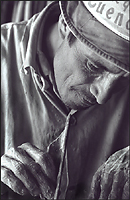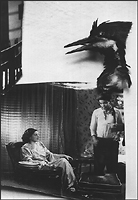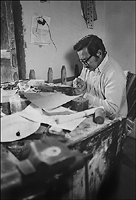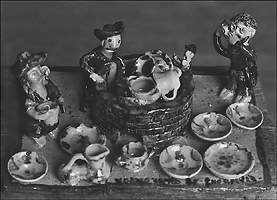



Home Ecuador
A tourist starting in Cuenca, who wished to spend the day shopping for fine crafts in Chordeleg, would have boarded one of the road-weary green buses for a dusty and bumpy, but scenic ride that deposited him at Gualaceo’s main square. From there he would walk to the opposite side of the square, past the fruit and vegetable stalls, the tables with warming pots of soup, and around several scrambling youngsters playing an impromptu game of soccer with an undersized ball. A record store nearby broadcasts a fast-paced “San Juanito” style song to enliven the lazy afternoon. Eventually a small pick-up truck arrives at the curb, one of the irregular, but inevitable vehicles that carry passengers on the road to Chordeleg. The truck is outfitted with a shell over the back to shelter luggage and thepassengers who sit on wooden benches around three sides. The benches are occupied by townspeople, other tourists, and the brown-skinned Indians in felt and panama hats, everyone with their freight of bags and boxes piled high in the space between everyone’s feet, and the excess tied to the top of the shell. If seating space is short inside, several men will volunteer to stand on the rear bumper with their hair blowing in the rushing breeze. If the truck is not yet full, the driver makes a circuit through town, honking his horn, and calling “Chorrr-de-leg!”. After a couple more stops, the truck passes out of town and down across the wooden bridge that spans the Rio Gualaceo. From there the rocky road rises in elevation, twisting and turning by brown adobe buildings and fields of corn with penco cactus borders. Sometimes a bag will bounce off the top of the truck and bounce in the road, and the passengers yell and pound on the side of the truck until the driver stops. The same signal is used if a passenger wishes to disembark somewhere mid-route. It is not long before the truck bounces up the street that brings it among the shops and homes of Chordeleg.
The truck stops in a large area in the center of town, half of which is dirt, and the other half a park with cement walks and trees. The attractive church, visible from the valley as it sits on its perch in the hills, lies on the other side of this square. The driver gets out and collects the 2-suc fare from each passenger, plus a little extra for excess baggage. Perhaps this driver is one of a pair of brothers who both drive this route. Though not twins, they look confusingly similar. He would appreciate it if you slip him one of the local “penny”-chocolates that taste so good.
Chordeleg is a small town with most of the houses and shops located on two main streets. A potter who lives there, Luis Villa, showed us around. A short way out of town was “Cerro Llaver”, a hill where one could see "prehistoric" stonework that looked as if retaining walls had been built while forming terraces for agricultural purposes. Luis said that it had been a ceremonial site, and he pointed at the fine view as explanation. Luis and his family also suggested that we should visit some nearby “ruinas”, and we accompanied them out of town into the folds of mountains beyond. The country was green and steeply rolling, but without the massive, bare granite bones of the Sierra Nevadas in California. The mountains seemed very old, well-worn and set in their ways, like the molars of an aging vegetarian. The “ruin” was a huge piece of rock, brown and green with the moss and lichen that grew on it. On top of the rock was a cross, and another was placed under a ledge near the bottom so that it looked like a crutch to keep the rock from tumbling over. A couple of smaller stones were lodged nearby. Indeed, they seemed like ruins, symbols of something long gone from that place. Our hosts assured us that the Incas once mined god there. We stayed for a while, lying in the sun-drenched grass and listening to the water run nearby.
Chordeleg was known throughout Ecuador for its crafts and, perhaps even more so, for its shops well-stocked with items of the tourist trade. There were knitted sweaters, embroidered shirts and dresses, rondadors (a traditional wind instrument), shoes of straw, dolls, pottery, items of carved wood, woven goods, and so on. Smiths of silver and gold have traditionally chosen Chordeleg as a place to practice their craft. Much of this work is silver filigree, an openwork-method of filling small spaces in jewelry. The jeweler buys his silver wire in a standard diameter which is too big for the fine filigree practiced here. In order to reduce the wire’s size, it is drawn through a series of holes in a metal plate, each hole smaller than the one before, until the desired diameter is achieved. This fine wire is layed and folded within silver forms in delicate patterns and designs to be used for earrings, rings, and necklaces.
On our first visit to Chordeleg, we passed along the main street with all its shops, and stopped in to watch a jeweler, Señor Espinosa, at work. His table stood by the doorway where the sun provided abundant light, and he could easily see whatever happened to be passing by. There was another man working with him who sat at a table across the small room. They were busy making “anillos”, rings for orders in Cuenca and Quito. Señor Espinosa was interested in our reasons for coming to Ecuador and, in response to our questions, offered information on the crafts of the area and places to go.
We later commissioned a couple of identical rings from him, and were met with another example of the “manana syndrome” which, by that time, we were accustomed to. This malady is suffered by visitors, particularly North Americans, to Latin American countries. Ecuador wasn’t peculiar in this regard. The visitor, or victim, suffers irritability and frustration when confronted with the fact that the thing promised for three weeks ago still isn’t ready, and perhaps never will be. One might think that Americans were better versed in patience at the hands of the telephone company, or from commuting in traffic jams. After several deadlines had passed, one day the rings were promised “por cierto”, for certain. By late in the afternoon on the appointed day they were almost finished, and we sat and watched, like vultures waiting for a meal, as Sr. Espinosa did the final soldering, fitting, and buffing. The rings were made of 18k gold. Sr. Espinosa considered 14k gold to be too hard, and thus difficult to work with, and 24k gold was too soft, and didn’t hold its shape well. The rings were worth the wait.
The manana syndrome was always affecting us, more or less, in our business dealings. Clearly, the problem lay with us, and our concept of time. Our conditioned punctuality was unnecessary there. One day we promised to meet Rolando, Luis Villa’s son, at a certain hour for a tour of one of the clay quarrys. We got a late start and apologized to Rolando. No problem. We certainly hadn’t kept him waiting. In fact, he seemed a little surprised that we’d come at all. Points in time did not exist, rather approximations. Time was not in short supply in Chordeleg, or in Gualaceo, either.
Sunday was market day in Chordeleg, and it had a scaled-down version of the market in Gualaceo. The unique thing here was the hat trade. Stacks of straw hats were brought in from weavers around the area and deposited at one particular building in town, where someone acted as broker. The weaving of the hats had been nearly completed. All that remained was the tying-off of the wild straw that sprang from the brims. The broker received all the hats and sold them to hat shops and individuals skilled in applying the finishing touches.
We became acquainted with a couple of families in Chordeleg who earned their livings as potters. Enrique and Hilda Orellana operated out of the government-funded Chordeleg Ceramic Cooperative. Enrique, a tall, thin man with dark hair and mustache, worked at the wheel making a number of different designs of plates, platters, vases, cups, pitchers, and bowls. His objects were lightly-made, with thin walls and smoothly finished. He was a skilled mechanic at the wheel, swiftly turning out quantities of identical pieces. A relative of his, Pomilio Orellana, had been a master ceramicist of the area and the subject of a short book by the government in praise of his work. Enrique became outraged when he spoke of the fact that Senor Orellana’s work had received recognition outside the area only after his life spent in poverty had ended. When I would take photographs in the studio, Enrique refused to let his picture be made, claiming he was too ugly, but, I thought he feared being taken advantage of.
Hilda Orellana worked at a table nearby, her back to the window so that the light fell before here on the paints and brushes, and the piece she held in her hands. After Enriques’s work had dried sufficiently, Hilda applied her distinctive flowery designs to each one. Occasionally she took a break from her flowers, and introduced a long-legged heron to a tall slim vase. The cooperative was equipped with modern tools, several fine wheels, an electric mixer for the clay, and an oil-fired kiln. Someone had accompanied the new equipment when it had arrived from the United States, and remained for a short time to give instructions on its use. The Ecuadorians did fine with the wheels and the mixer, but that kiln was a source of anxiety and frustration. The heat was very difficult to control. Several times we visited after a firing, expecting to see all the beautifully finished work, but instead were met with heaps of broken pots and pieces ruined by the bubbling of the glaze. We felt bad, but the Orellanas felt infinitely worse. When the pieces came out well, they were placed on the shelves that occupied parts of the studio. Then they were easily inspected by tourists, or buyers for shops in town or from the larger cities.
Luis Villa had his own set-up at home. His eldest son, Rolando, helped him on the wheel, and his wife, Selina, contributed her decorative skills. The rest of his many children helped in their individual ways. Luis was a short, thin man, a little nervous, but sharp and quick, and he enjoyed joking with us. He was a very able potter and tile maker, with great knowledge of his materials and tools. The Villa “studio” was spread here and there around his property. The room next to the living quarters contained finished or semi-finished pieces occupying the table and floor. Outside was a sheltered area for the clays and a “machine” for grinding and mixing. In another area were two more rooms, one a kitchen, and one a drying room. In between these was a sheltered space for the two throwing wheels, with the kiln nearby. When the sun was hot, the yard was full of drying plates and bowls.
Luis had personally fashioned all his tools. The grinding machine near the living quarters consisted of a rock at the bottom of a wooden shaft, with a crank at the top end. The rock fitted nicely into a concave bowl of stone. As the crank was turned, the rock traveled around the bowl, an up-dated version of the mortar and pestle. It consumed 6-8 hours on the crank to prepare the mixture of ingredients that constituted the glazes. The two throwing wheels were made entirely of wood with a kicking stone for power. The round wood-fired kiln was built of adobe brick, and had to be carefully attended throughout each firing.
The clay came from several locations near and far, and varied in quality from place to place. One old quarry was about a fifteen minute walk from town, easily seen from the road as a white scar in the surrounding dark dirt. The clay was dug from the earth with pick and shovel, loaded into sacks, and brought to the house by car. After the clay had been pulverized, it was mixed with water and kneaded like a lump of bread dough until it was the proper consistency. Several qualities of clay were mixed according to the objects to be made. We watched one day, sitting in chairs against the adobe walls of the kitchen, as Luis took a large lump of clay and settled himself at the wheel. He made two containers which were later connected to form a single vessel, two teakettles plus lids and spout, two different-sized plates, and a large platter. With the clay that remained, he made handles. He worked quickly, seemingly joyously, while a train of amusedexpressions crossed his face as accompaniment to his efforts.
Selina worked with the brush and glazes to add the distinctive designs that characterized the Villa pottery. Her work was not as refined as Hilda’s, but was more tradititional and used more folkloric designs. Luis’ blue and green glazes were his trademark. He was able to support his family with his sales and commissions, which ranged from decorating the walls of a new restaurant in Cuenca with plates and platters, to covering the wall of a hotel in Quito with tiles.
When a large number of pieces had been thrown, dried and decorated, Luis prepared to fire them. He had already laid in a supply of good-burning wood. The kiln was about five feet high and five feet in diameter. There were two holes in the walls at the bottom of the kiln, one opposite the other, to enable the fire to breathe and be controlled. The largest pots and vases were brought first and laid on adobe shelves set into the walls above the burning area. Smaller pieces were set inside and around these, and carefully piled one on top of the other until the heap of pottery billowed out the open top of the kiln. Numerous shards and old tiles were used to completely cover the work to be fired. Selina placed a load of wood in one of the holes at the bottom and ignited it, the beginning of a ritual of slowly increasing the temperature to ensure the proper and safe firing of the clay. This process took about thirteen hours to complete, and then the pieces were allowed to cool before being removed from the kiln. A second firing was performed later after the work had been dipped in a clear glaze.
Luis was interested in building a new and larger kiln, perhaps in conjunction with Enrique, who was discouraged with the modern oil-burning kiln at the Cooperative. Luis needed adobe bricks which weren’t available locally. The closest source was in the town of Sigsig.
Sigsig was a forty-five minute trip by car on a rough & rocky road chopped out of the mountainside following a watercourse most of the way. The town looked to be about the same size as Gualaceo, perhaps a bit larger, with unpaved streets. Any new structures were still being built with adobes, and these could be seen stacked in rows along some of the town’s streets.
It seems that no matter how new an adobe is, it looks ancient. Perhaps this is partly due to the brown clay and mud with which they are made. Simply packing these already world-weary components into a rectangular solid doesn’t give that snappy fresh look that a ‘new coat of paint” is famous for. The first rain that touches them turns the loose dust on their surfaces to mud, and they instantly appear to have withstood several decades of storms and baking by the sun. According to Luis, the better quality adobes are of a lighter toned mud, and these are in demand for houses – “muy duro”, very hard. The others are darker in color, lower in quality, but also better suited for Luis’ purpose. We walked down a slope towards the river that ran through the canyon nearby. Luis, who said he hadn’t been to Sigsig for several years, guessed that there might be some adobes available at a house there, and he was correct. He could buy what he needed at about 1.5 sucs (.06) apiece. We continued our tour of the town, and happened by a large number of dark adobes that included the added ingredient of straw in their composition. To Luis, these were even more desirable. A young boy who had been following us offered to guide us to the owner of these adobes. As we walked, we discovered that the boy had a great vocabulary of English words without the meanings, or so he let on. The owner of the adobes had intended to use them to build a house, but Luis was able to arrange to purchase the 150 that he needed, and which he would come back for another day.
A river cut through the valley below the town, and we saw a man walking up the hill with a string of fish. The countryside there was very green with lots of trees, especially eucalyptus. There were some mines in the area, copper and perhaps silver. Luis showed us one hole where we thought we could see some bats hanging in the dark passage. According to Luis, an “extranjero” (stranger) had entered this tunnel one day and never exited.
Our ride back to Chordeleg and Gualaceo was in a car more comfortable than the trip out. At one point, a dog ran out in front of the vehicle, and the driver barely lifted his foot from the gas as we passed over it, and went on without a pause.
Just before we were to leave Ecuador, we paid a last visit to Luis. Rolando, at the suggestion of some potential customers, had begun making some ceramic groupings of figures, scenes from the market, and country life, and a performing rock-and-roll band. They were all quite well-done. The one which they found most amusing was a scene around the potter’s kiln, featuring the potter and his assistant placing pieces in the kiln, and a near-sighted gringo photographer recording it all on film.